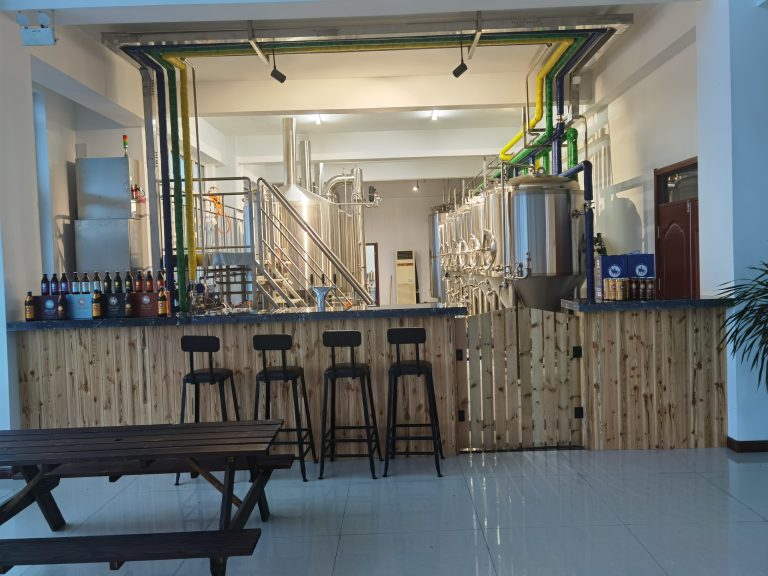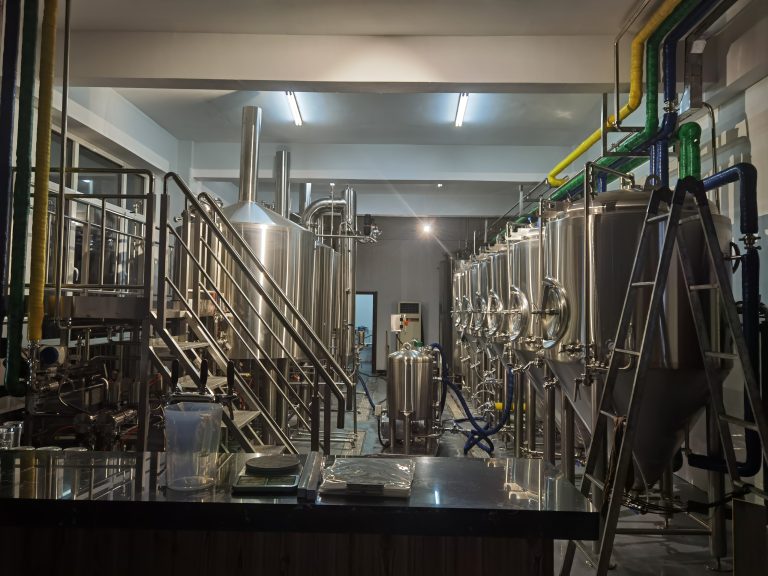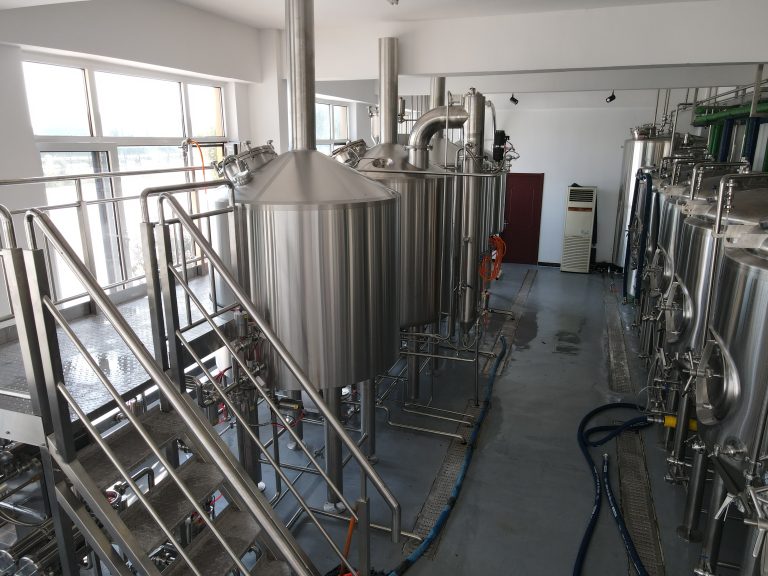


A 1000 liter brewing system typically refers to the capacity of the brewhouse, which is the vessel where the initial stages of brewing take place. This system can produce about 1000 liters (or approximately 264 gallons) of beer per batch. It’s a sizeable setup suitable for small to medium-sized craft breweries or brewpubs.
1.A 1000liter micro brewing system is an excellent choice for microbreweries, brewpubs, and small craft breweries looking to produce beer in moderate quantities. With a capacity of about 264 gallons (1000 liters) per batch, this system allows for efficient production while maintaining flexibility for diverse beer styles and recipes.
2.1000L micro brewing system specification:
| Output/Brew | 1000L |
| Brew/Week | 2~6 |
| Output/Week | 2000L~6000L |
| Electric Supply | 3phase/380(208, 415,480,575…)v/50 (60)Hz |
| Heating Source | Electric/Steam/Direct Fired Heating |
| Area Request | >70m2 |
| Brewmaster | 1 |
3.1000L Micro Brewing System Configuration:
| Name | Components | Specification |
| Grain Milling Unit | Grain miller | Stainless steel 304, Double roller, rollers distance adjustable |
| Grain auger | Conveys grist from malt mill to grist case;
Inside stainless screw, outside PPR protection tube; Associated motor with frequency conversion. |
|
| SS grist hopper | Stainless steel304 | |
| Brewhouse system | Mash/lauter tun | Grain rake with VFD Laser cutting V-wire False Bottom Easy clean and detachable sparging spray ring Multihole wort collect ring, anti-rinserWith side grain out door Tank light assemblies Mash hydration assembly Rotary CIP spray balls Level sight tube. |
| Boiling kettle/whirlpool tank | Steam Jacket /direct gas fired heating/electric heating Steam vent with condensate ring for kettle stackTank light assemblies Rotary CIP spray balls Tangential whirlpool entry Level sight tube. |
|
| Wort pump | Sanitary wort pumps with variable speed control. | |
| Working platform | OSHA compliant platforms with safety railings & stairs, Cellar package with brewers hoses, valves and fittings . | |
| Hot liquor tank | Steam Jacket heating/direct gas fired heating/electric heating
Sight gauge for water level With SS HLT pump with variable speed control. |
|
| Wort chiller | SUS304/316 plate, with wort aeration system. | |
| Beer Fermenters/unitanks | Beer fermenter | Interior and exterior finish polished to a sanitary finish
Interior finish pickled and passivated Exterior brushed, #4 finish Fully welded exterior shell 60 degree cone bottom, with an average of 25% head space Rotating racking port Glycol cooling jacket on cone and bottom Ladder hooks Inoxpa butterfly valves, sample valve, 2” pressure vacuum relief valve RTD Probe Tension braces on legs Sanitary tri-clamp connections. |
| Serving&bright beer tanks | Bright beer tank | Inoxpa butterfly valves, Perlick sample valve
Micromatic level gauge, PVRV Clamps and gaskets, pressure gauge, carb stone Stainless steel legs with stainless leveling footpads Interior shell: 304 stainless steel, thickness 3mm Exterior shell: 304 stainless steel, thickness 2mm Interior and exterior finish polished to a sanitary finish Interior finish pickled and passivated Exterior brushed, #4 finish Fully welded exterior shell Dished top and bottom, with an average of 15%-20% head space Carbonation port Side or top manway door, Dimple jacket cooling jackets Polyurethane insulation Level gauge connections CIP arm and spray ball Sanitary tri-clamp connections. |
| Glycol cooling system | Glycol tank | Insulated conical top and sloped bottom
Liquid level sight tube for water level Rotating CIP spray ball. |
| Cold water tank | Cooling jacket on tank with PU insulation
Liquid level sight tube for water level Rotating CIP spray ball. |
|
| Glycol chiller | Assembly unit, wind cooling, environmental refrigerant: R404a or R410a, compressors and electrical components meet UL/cUL/CE certified | |
| Glycol/cold water pump | Sanitary SUS304, VFD control | |
| Control unit | Brewhouse and fermentation process Controlling | Manual button control panel or PLC control with touch screen for special, control panel with RTD & solenoid valves. |
| CIP unit system | Caustic tank | Electric heating element inside |
| Sterilize tank | Stainless steel 304 | |
| Transfer&Control | Portable sanitary CIP/wort pump, SS cart & VFD controller | |
| Others | Option | Piping flow panel for Brewhouse |
| Brewhouse Separate PLC Controller |
4.The Advantages of 1000 Litre Micro Brewing System
A 1000-liter micro brewing system offers several advantages for breweries looking to scale up their production:
1).Increased Production Capacity: Compared to smaller brewing systems, a 1000-liter brewing system allows breweries to produce larger volumes of beer per batch, meeting higher demand without sacrificing quality.
2).Efficiency: Larger batch sizes often result in increased efficiency in terms of time, labor, and resources. With fewer batches required to produce the same volume of beer, breweries can optimize their processes and reduce overall production costs.
3).Consistency: Larger brewing systems typically offer more precise control over the brewing process, leading to greater consistency in the final product. This consistency is essential for maintaining the quality and flavor profile of the beer, which is crucial for building a loyal customer base.
4).Flexibility: While a 1000-liter brewing system is larger than many smaller brewing setups, it still offers enough flexibility for breweries to experiment with different recipes, styles, and ingredients. This flexibility allows brewers to innovate and respond to changing consumer preferences without committing to excessively large batches.
5).Scalability: Investing in a 1000-liter brewing system provides breweries with room to grow. As demand increases, additional fermenters and equipment can be added to the system to further increase production capacity without the need for a complete overhaul of the brewing setup.
6).Professional Appearance: For breweries looking to establish themselves in the market or expand their distribution, a larger brewing system can lend a more professional appearance. It signals to customers and distributors that the brewery is capable of producing significant volumes of high-quality beer.
7).Economies of Scale: With larger batch sizes, breweries can take advantage of economies of scale when purchasing ingredients and packaging materials. Bulk purchasing often leads to lower per-unit costs, further improving profitability.
Overall, a 1000-liter micro brewing system offers a balance between production capacity, efficiency, flexibility, and scalability, making it an attractive option for breweries looking to grow and succeed in a competitive market.